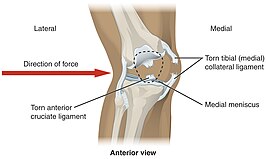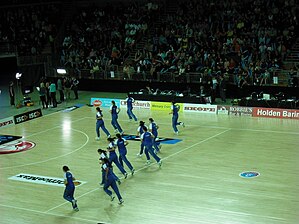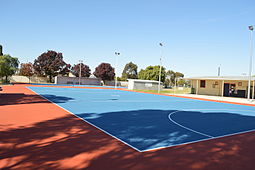Injuries in netball

Netball is a sport that has one of the largest female participation rates within the Commonwealth, most popular in the United Kingdom, Australia and New Zealand, with more than 20 million athletes participating in the sport. Netball is a ball sport played by two teams of seven players in which goals are scored by shooting the ball through a netted ring.[1] Netball relies heavily on muscular endurance and bursts of rapid acceleration to “break free” from an opponent as well as, sudden and rapid change of directions in combination with jumping to receive a pass, intercept a ball or rebound.[2] The sudden stop-start motion of the game is what often leads to serious injuries in participants. Higher grade players, in both senior and junior competitions, are more susceptible to injuries than lower grade players, due to the high intensity and rapid pace of the game.[3] An injury is most commonly defined as one that has occurred while participating in sport and which led to one of the following consequences: a reduction in the amount or level of sports activity; need for medical advice or treatment; and/or adverse economic or social effects for the athlete.[4]
Common soft tissue injuries in netball
A soft tissue injury is the damage of muscles, ligaments or tendons in the body. The most common soft tissue injuries in netball occur to the ankles, knees and hands. The main cause of these injuries is due to incorrect landing. Other factors influencing injury include; tripping, collisions with other players, being struck by the ball, over-exertion and fatigue.[3]
Ankles
In netball the ankle joint is most susceptible to injury and accounts for 31% of the injuries sustained in the sport.[4] A sprained ankle is a tear or complete rupture of a ligament. The most commonly injured ligament is the Anterior Talofibular Ligament. This ligament is on the outside of the ankle and injury occurs when the sole of the foot rolls inwards. A minor sprain may only need a week to recover, however severe ankle sprains can result in a player being out for 6–10 weeks.[3]
Knees

Knee injuries are the second most common injury in netball and are the most serious in regards to cost and disability. Studies show that majority of knee injuries are new injuries, and those who sustain a knee injury often withdraw from participation in netball. The most common knee injuries are meniscal and major ligament sprains/ruptures. The most commonly injured ligament is the Anterior Cruciate Ligament(ACL). The ACL allows a twisting motion at the knee. Common symptoms of an ACL rupture include a “popping” sound at the time of the injury, severe pain, swelling and a feeling of instability. ACL injuries are difficult to effectively diagnose without the assistance of Medical Resonance Imaging (MRI). A ruptured ACL will require knee reconstruction surgery that will result in the athlete being out of the game for 9–12 months.[3]
Hands/other
Hand injuries usually involve joint ligamentous sprains and fractures. Children most commonly injure hands, in particular their fingers.[2] “Other” types of injuries in netball vary including; lower leg strain, quadriceps haematoma, rotator cuff shoulder problems, an elbow joint dislocation, a radial fracture, and back problems.[3]
Treatment
As soon as an injury occurs game time must be held until the player has been properly assessed and removed from the court if need be. It is essential that players seek immediate help from a qualified first aid provider or health practitioner. Any netball injury should be treated by using the P.R.I.C.E.S., D.R.S.A.B.C., T.O.T.A.P.S. AND R.I.C.E.R. regimes:[5]
P - Protect
R - Rest
I - Ice
C - Compression
E - Elevation
S - Stabilise
D - Danger
R - Response
S - Send for help
A - Airway
B - Breathing
C - Circulation
T - Talk
O - Observe
T - Touch
A - Active movement
P - Passive movement
S - Skills test
R - Rest
I - Ice
C - Compression
E - Elevation
R - Referral
If an injury occurs ensure that all netball players receive adequate treatment and full rehabilitation before returning to play. Serious ankle and knee ligament ruptures will require reconstructive surgery. It is essential to follow all recovery and rehabilitation programs fully to prevent any injury from re occurring.[2]
Netball injury prevention
Good preparation

In order to prevent netball injuries, essential pre-season training is required before commencing the playing season. The distance travelled by elite players over a game ranges from 7 km (shooters/ defenders) to 8.8 km (centre court players).[6] A game does not only consist of basic running; players are required to accelerate in rapid bursts for the majority of the game. In pre-season training players must undertake fitness programs that focus on power, strength, agility and flexibility, especially of muscles around the ankles and feet. It is important that fitness testing is conducted prior to competition to ensure readiness to play the game.[2]
Good technique
Training should consist of netball specific exercises that focus on enhancing body balance, landing control, change of direction and catching passes. It is essential for coaches to undergo regular educational updates to make sure the information they have about correct training drills is current. It is very important that children are properly taught the fundamentals of netball before they participate in game situations. Any incorrect techniques should be corrected at a young age before they become a bad habit.[6]

Warm up
A warm-up should never be overlooked in netball as it plays a vital and effective role in preventing injury. A warm-up is essential before physical activity to; prepare the body for vigorous exercise, reduce the risk of injury, reduce muscle stiffness and mentally prepare the athlete. Any warm-up should consist of running, dynamic movements and dynamic stretches. It should last for a minimum of ten minutes.[4]
Equipment/clothing
In netball it is essential that the goal posts are firmly fixed to the ground and have a padded post protector around them. All courts should be a firm, smooth surfaces with no loose gravel or hazards. The most important uniform item for any netball player is the shoes. It is highly recommended that players wear netball specific shoes, as they are tailored to the demands of the game and provide the correct level of support and cushioning. It is also recommended that players should wear braces or strap their ankles to provide extra support and decrease the risk of a major injury occurring.[2]
Psychological effects of having a major injury
For many netball players a serious injury can be a traumatic life event that results in physical and psychological ramifications. The main psychological effects include the initial emotional response of experiencing an injury, the psychological factors that influence the recovery process, and the psychological impact of an injury on the athletes future performance. It is important to remember that not all injured athletes will experience the same cognitive and emotional responses.[7]
Emotional responses
During injury and recovery players may experience different mood states. The most commonly found mood disturbances are increases in depression, tension and anger. The emotional response will depend on how extreme the injury is. Self-efficacy is defined as one’s belief in ones ability to succeed in specific situations. Physical self-efficacy is often affected by an injury. Players will often enter an extremely negative state of mind immediately after an injury, however; during recovery they often become exceedingly positive.[7]
Self-motivation
Most often players will be highly motivated to get back to playing netball as soon as possible. However it is important to remember that injured athletes will have good and bad days. During rehabilitation an athletes motivation and enthusiasm for treatment may decrease if they are experiencing setbacks or a period of little or no improvement. It is important for athletes to have a good support network to keep them positive and focused during these harder times.[7]
Confidence
Physical recovery is critical, however, psychological rehabilitation is the most important part of recovery. Even though a player may be physically ready to return to netball, they may not be psychologically ready to play. Various doubts, fears and anxieties may surface when thinking about returning to netball. The athlete may fear they are going to be a different player, they will not meet their coach or teammates expectations or that their physical fitness will not return to pre-injury state. This will result in the athlete putting a huge amount of pressure on themselves. This anxiety and tension can lead to the following outcomes: reinjury; injury to another body part; lowered confidence resulting in a temporary or permanent performance decrement; general depression; and fear of further injury, which can sap motivation and the desire to return to competition.[7]
Dealing with psychological effects
The most successful psychological techniques that aid injury recovery are; good interpersonal communication skills, positive reinforcement, setting realistic goals, knowing methods for positive self-thoughts, coach support, and keeping the athlete involved with the team.
Returning to pre-injury levels & goal setting
Determining a successful return to netball from injury for most athletes is the ability to train and compete at pre-injury levels and standards. Measuring this includes things such as; reaching past endurance fitness test levels (beep tests); the ability to perform and complete sport-specific training exercises; and maintaining performance. Achieving these goals at training will best prepare an athlete for what they will experience during competition standards. It is important for the athlete to set realistic goals that they are able to achieve. They must understand that these goals may need to be long term, as not everything can be achieved over night. It is important that goals are flexible because when injured the rehab progress is often unpredictable.[8]

Active participation in rehabilitation
Athletes that are engaged in their rehabilitation program are likely to cope with their injury more successfully. Physiotherapists state that athletes who show interest in their rehabilitation by; communicating well, asking questions, listening well to advice, and providing feedback, are more likely to have a positive psychological response to their injury.[9]
Strong support systems
It is very important to have social support during the injury, rehabilitation and sports returning phase. This may include coaches, trainers, friends and family. The support of these people is essential for times when the athlete may need positive encouragement around them. The athlete should talk to someone they feel most comfortable with and who is going to listen and support them.[9]
Sports psychologist
It can be beneficial for an injured player to work with a sports psychologist. Coach and family can be helpful, however there may be times when they are too close to the situation and where an outside point of view is needed to help.[8]
Take it slow
It is important to remember that there is no rush to get back to netball. Athletes should feel prepared and confident before returning to competition. It is important to take part in game play situations at training. The athlete may also want to start in a lower grade then usual to help ease back into the game. They should aim to play one quarter in their first game back, and slowly build from there aiming to play a full game as they have progressed and experienced success.
Controversies
Hypermobility and injuries in junior netball players
Hypermobility is defined as a condition in which an individual’s synovial joints have a range of motion beyond normal limits. Hypermobile joints can be a performance enhancement in some sports, for example spin bowlers in cricket. However some studies suggest the increased risk of joint dislocations, sprains and joint hyperextension in athletes with hypermobile joints. They believe that recognising hyper mobility in young female athletes may reduce the risk of injuries occurring. On the contrary, others suggest that hyper mobility is not associated with an increased incidence of injuries in junior netball players.[10]
Serious/career threatening injuries in elite netball players

- 2005
In October 2005, Australian captain Liz Ellis, suffered a career-threatening knee injury after tearing her ACL in a match against New Zealand. This injury ruled her out of the chance to play at the 2006 Commonwealth Games. Ellis said that she had to reignite her passion and love for the game that had been her life. Ellis states that “It was soul-destroying to watch my team walk out without me and realise, hey, they can play without me”.
She worked extremely hard on her rehabilitation, her knee repaired and her passion was restored. Ellis produced some of the best netball of her career in the two years that followed. She ended her 18-year career in her 122nd test with Australia winning the world championship 42-38. She overcame all critics and odds after coming back from her knee injury.[11]
- 2012
West Coast Fever captain, Ashleigh Brazill, ruptured the meniscus in her left knee late in the 2012 ANZ Championship season. Brazill had been selected to represent Australia in the 2012 Constellation Cup, but unfortunately had to withdrawal from the team. Brazil worked to build the strength back in her knee and went on to resume playing in the following 2013 season.
- 2014
In October 2014, Casey Kopua suffered a knee injury during the 2014 Constellation Cup. Kopua ruptured the patella tendon in her left knee and had knee surgery to repair the tendon that would result in her missing up to 6 months of netball.[12]
- 2015
In April 2015, Melbourne Vixens mid courter, Madi Robinson ruptured the anterior cruciate ligament in her right knee. Robinson missed out on the 2015 Netball World Cup.
See also
References
- ^ Chandler, Phillip T.; Pinder, Sarah J.; Curran, Jourdan D.; Gabbett, Tim J. (2014-01-01). "Physical Demands of Training and Competition in Collegiate Netball Players". Journal of Strength and Conditioning Research. 28 (10): 2732–2737. doi:10.1519/jsc.0000000000000486. PMID 24983848.
- ^ a b c d e "Netball Australia". physioworks.com.au. Retrieved 2015-09-03.
- ^ a b c d e Hopper, D; Elliott, B; Lalor, J (1995-12-01). "A descriptive epidemiology of netball injuries during competition: a five year study". British Journal of Sports Medicine. 29 (4): 223–228. doi:10.1136/bjsm.29.4.223. ISSN 0306-3674. PMC 1332230. PMID 8808533.
- ^ a b c McManus, A.; Stevenson, M.R.; Finch, C.F. (2006-01-01). "Incidence and risk factors for injury in non-elite netball". Journal of Science and Medicine in Sport. 9 (1–2): 119–124. doi:10.1016/j.jsams.2006.03.005. hdl:20.500.11937/45869. PMID 16621712.
- ^ "Guidelines". Retrieved 2015-09-03.
- ^ a b "245 Quantifying the physical demands in netball to develop training guidelines that assess player preparation and reduce injury". Journal of Science and Medicine in Sport. 10: 85. 2007-01-01. doi:10.1016/s1440-2440(07)70252-9.
- ^ a b c d Quinn, Ann M.; Fallon, Barry J. (1999-01-01). "The changes in psychological characteristics and reactions of elite athletes from injury onset until full recovery". Journal of Applied Sport Psychology. 11 (2): 210. doi:10.1080/10413209908404201.
- ^ a b Podlog, Leslie; Eklund, Robert C. (2009-09-01). "High-level athletes' perceptions of success in returning to sport following injury". Psychology of Sport and Exercise. Research Quality in Sport & Exercise Psychology. 10 (5): 535–544. doi:10.1016/j.psychsport.2009.02.003.
- ^ a b Francis, Susan R; Andersen, Mark B; Maley, Paul (2000-01-01). "Physiotherapists' and male professional athletes' views on psychological skills for rehabilitation". Journal of Science and Medicine in Sport. 3 (1): 17–29. doi:10.1016/s1440-2440(00)80044-4. PMID 10839225.
- ^ Smith, R.; Damodaran, A. K.; Swaminathan, S.; Campbell, R.; Barnsley, L. (2005-09-01). "Hypermobility and sports injuries in junior netball players". British Journal of Sports Medicine. 39 (9): 628–631. doi:10.1136/bjsm.2004.015271. ISSN 1473-0480. PMC 1725309. PMID 16118300.
- ^ "Knee injury puts Ellis's Games Hopes under cloud". The Sydney Morning Herald. October 31, 2005. Retrieved September 29, 2023.
- ^ "Kopua's injury blow for Magic". ANZ Championship. 14 October 2014. Archived from the original on 20 January 2015. Retrieved 2015-09-03.
